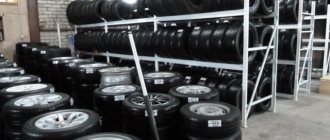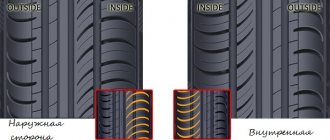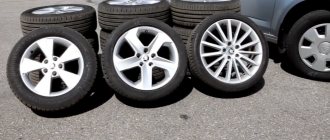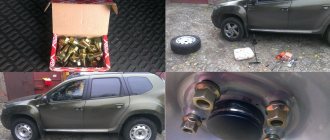In this case, you should familiarize yourself with the standards that provide for the creation of optimal conditions in the premises where tires will be stored.
We’ll talk further about how and where to store tires without rims.
Tire storage conditions
Storing tires without rims provides for the creation of comfortable conditions that prevent the destruction of rubber. Therefore, it is necessary to ensure a stable microclimate in places suitable for storage.
The following factors have a negative impact on the material , causing earlier aging of tires, which can be clearly seen in the table:
| Factor | Negative Impact |
| Unstable temperature indicators | A sharp change in temperature, even if it does not exceed the permissible values, causes rubber aging. There is a risk of reducing the elasticity of the material, deformation of the tires, and the formation of microcracks on them. |
| Presence of heating devices in the room | Tire racks are recommended to be located at a distance of 1 m from them. Otherwise, this will lead to drying out of the rubber. |
| Ultra-violet rays | Ultraviolet exposure to tires causes elastomer aging. |
| Increased humidity/dryness | Exceeding permissible standards negatively affects the elasticity of the material. In an excessively dry room, rubber cracks, and when there is excess moisture, fungi quickly develop. |
| Aggressive substances | The presence of gasoline, lubricating oils, and diesel fuel in the room provokes the possibility of dissolution of rubber components. Alkalis, acids and industrial solvents are also harmful to the material. |
Optimal humidity levels are 50 – 65%. If there is no ventilation in the room, it must be ventilated regularly.
Features for different seasons
As for the temperature regime, not only its values and the type of tires are taken into account. The values must be maintained to be appropriate for the operating conditions of the product.
The fact is that the use of seasonal tires depends on the composition of the rubber . Therefore, it should be taken into account that summer tires are not suitable for frost, while winter tires are not suitable for heat.
Summer tires can withstand high temperatures. It must be stored in a dry place out of direct sunlight. The temperature should not be below zero degrees. You cannot keep summer tires on an uninsulated balcony. Summer tires dry out and crack in the cold.
It is not recommended to store winter tires in a warm room. They lose their elasticity when exposed to heat. This leads to a decrease in the tire's grip on the surface and causes slipping on ice. It is strictly forbidden to leave winter tires in the sun.
The general rule for winter or summer tires is the undesirable presence of heating devices closer than at a distance of 1 m. The optimal temperature for storing tires is 8 - 23 ° C.
Tires stored in improper conditions become dangerous to use. The reason is a violation of the structure of the material, rapid wear and, as a consequence, loss of operational safety.
How to properly store tires: with and without rims (important instructions)
Twice a year, motorists in Russia change their car tires. Most often, cars are “changed” to winter tires at the end of October, when the maximum daytime temperature does not exceed five degrees Celsius and stays at this level for at least a week. In this weather, night temperatures steadily drop below zero, and ice may form in the morning. Drivers in the central region usually switch to summer tires in mid-April, when stable above-zero temperatures set in.
The tire replacement procedure itself is unlikely to cause any difficulties even for novice motorists - all you need to do is come to a specialized tire shop. Much more problematic is the issue of tire storage. After all, improper storage of tires can lead to damage and rapid wear of even good and expensive tires. To prevent this from happening, the driver should follow a number of storage rules that apply to both summer and winter tires.
In what position should you hold it?
The safety of tires directly depends on the position in which they are placed for storage. There are several accommodation options:
- horizontal,
- suspended,
- vertical.
However, for tires without rims, only one placement method is suitable - vertical. When positioned horizontally, compression and deformation of the rubber occurs, which makes it impossible to further operate the tire. When suspended, the tires stretch out and also become unusable.
When storing tires without rims, here are some important tips to keep in mind:
- The surface on which tires are installed must be level and durable.
- The best option is a metal or wooden floor or wall rack.
- Tires can be placed close to one another or with a small gap between them.
- However, storing other, even light objects, on car tires is not allowed. This will lead to tire deformation.
- It is recommended to turn wheels without discs every 1.5-2 months to prevent deformation of the tire sides and maintain its correct shape.
To ensure comfortable storage conditions, you can purchase ready-made shelving and racks for vertical arrangement of wheels without disks.
Some of them have a concave surface that ensures ideal pressure distribution throughout the rim. Such designs are durable, easy to clean and provide a high level of tire support.
Force majeure
What to do if storage standards were not met and the tire, or even the entire set, was deformed. Situations are different, and the degree of negligence varies for everyone. Simply put, all that remains is to throw away the wheels, but even here everything is not so obvious. As it turned out, it is impossible to leave rubber next to the trash can, since this element is subject to special disposal.
You can go and change your shoes to a tire shop, and at the same time buy a new set of wheels there. These guys often have an alliance with companies that are engaged in the safe disposal and processing of such rubber products. Each wheel will cost you from 100 to 200 rubles, depending on tread wear and the manufacturer. Additionally, pay 50-70 rubles per spike.
Unfortunately, not all services accept used tires for further processing . And it’s not a fact that the guys who did agree transform the raw materials properly, since things are frankly lousy with recycling in Russia, since the demand for old tires in the country is catastrophically low. Your wheels may simply be thrown into a general landfill, although this is prohibited. On the other hand, the responsibility is made a little easier by the fact that it was not you who did it, but third parties, although it doesn’t make it any easier.
Proper wheel preparation
The preparatory stage has its own characteristics . Their further suitability for use, as well as safety on the road, depends on the quality preparation of tires before long-term storage.
Standard processing includes the following mandatory procedures:
- Cleansing. At this stage, it is necessary to remove dust, oils, dirt, and pebbles stuck in the tire.
- Washing. Wash away dirt and chemicals with plenty of water.
- Drying. Dry the rubber thoroughly to avoid the damaging effects of excessive moisture on the material.
- Conservation. Treatment of tires with special compounds that prevent the likelihood of exposure to negative factors during long-term storage.
For this purpose, a special silicone grease can be used as a protective composition. Its use prevents drying out and the appearance of microcracks in the rubber. Before processing, you should read the Instructions and strictly follow them. Ignoring the recommendations from the manufacturer can ruin the tires. - Wheel markings . This nuance helps you later easily figure out which tire to install and where. To do this, you can use a marker or special stickers.
Proper preparation of tires without rims and provision of comfortable storage conditions significantly extend the life of tires.
Tire processing
Before placing tires in the required storage location, the rubber must be treated. First, the rubber is washed and dried. Various contaminants are removed from the surface. Next, you should treat the rubber with a special compound. The principle of processing is its protective properties. Before spraying the solution, you need to read the instructions and follow all processing steps so as not to damage the tires.
This chemical can be purchased at automotive stores. The seller will give you advice and help you choose a product. Those chemicals that are used to blacken rubber are not suitable for storage. After treating the tires, it must be placed in a dark plastic opaque bag to prevent ultraviolet rays from penetrating. The bag should not be closed too tightly to avoid condensation.
Where can?
The options for placing tires without rims are quite varied. Even if there is no special room, they can be stored in utility rooms, on the balcony, in the garage and even in the cellar. But each option has its own characteristics. They need to be taken into account.
On the balcony
This room is used very often and can be considered an acceptable option for storing tires. The following features should be taken into account:
The balcony must be insulated, which will create the necessary microclimate with acceptable temperature and humidity.- A prerequisite is that the tires must be protected from exposure to ultraviolet radiation. Otherwise, the rubber will become unusable.
- It is unacceptable to store tires on open balconies. There is a very high risk of the negative effects of precipitation, temperature fluctuations, sunlight, cold and heat.
Only if acceptable conditions are met can tires be stored on the balcony. The vertical placement rule also remains mandatory.
In the garage
An excellent place to store tires without rims is a regular garage. The reason for this is that the negative effects of ultraviolet radiation are excluded.
However, there are also disadvantages:
- It’s cold here in winter, so summer tires harden and become deformed;
- heating appliances can dry out the air;
- it is necessary to maintain a distance from heating means;
- possible violation of humidity boundaries;
- the presence of chemicals in the room also negatively affects the material.
A metal garage is not suitable at all. During the day, such a room overheats and cools down at night. In it, tires are exposed to the negative effects of temperature changes.
In the attic
Storing tires in the attic has a number of its own characteristics. Among them:
- The need to place the tire rack away from the window and door to avoid harmful exposure to sunlight.
- Possibility of roof leakage.
- Snow or rain.
It is recommended to prevent these nuances. Only after this can the wheels be placed in the attic.
In the cellar
To store tires in a cellar, you need to consider some factors:
- high humidity;
- lack of proper ventilation;
- risk of fungi settling on rubber.
These moments can lead to damage to the rubber structure. As a result, it becomes unsuitable for use.
At the tire center
The advantage of service centers over each of the options considered is obvious . All the necessary conditions for high-quality and safe storage of seasonal tires are provided here:
- the required temperature level for winter and summer tires is maintained;
- there is no likelihood of sudden temperature changes;
- an optimal level of humidity is ensured;
- exposure to ultraviolet radiation is excluded;
- there is no danger of exposure to aggressive substances;
- the centers are equipped with special racks for each type of tire.
Storing seasonal tires without rims in a tire center is the best option. Here the tires will be perfectly preserved until the next use.
How to properly store tires and rims
When storing rubber and rims correctly, the possibility of moisture and dust particles getting on the inside of the tire is completely eliminated. Such tires, on the contrary, can be stored in stacks without the risk of deformation. However, after some time (for example, once every two months), the wheels that lie on top of each other should be swapped. In addition, rubber with metal disks can be hung on special hooks to save space. It is strongly recommended not to leave tires and rims in a vertical position to avoid possible deformation.
Consequences of improper storage
Mistakes made when storing tires cause significant harm to them, including serious damage that prevents their further use.
Here is a list of negative consequences:
- The tire is deformed, making it impossible to install it on the rim.
- If such a tire is pulled on with force, it will interfere with inflating the tube.
- Significant reduction in tread adhesion to the road surface.
- Tire compression when stored horizontally in a stack. As a result, the tread surface becomes convex, which reduces the stability of the car.
- Storing tires without rims on hangers leads to their deformation, giving the tire an oval shape. It will be impossible to pull it onto the rim.
- Deformation due to improper storage reduces the adhesion of the tire to the disc.
- A decrease in the elasticity of rubber, which causes microcracks to appear.
Each of the problems described can ruin the tire without the possibility of repairing the damage. Therefore, all storage recommendations should be followed with the utmost responsibility.











